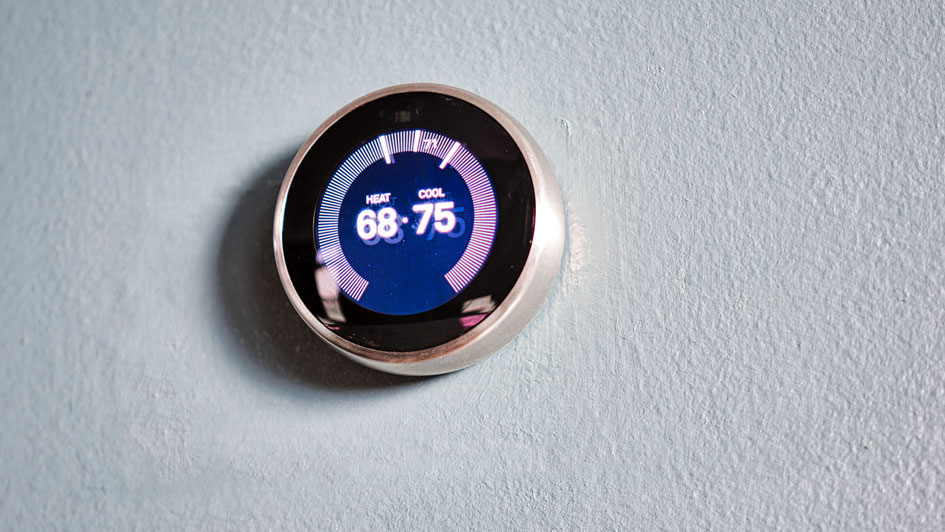
A Nest Thermostat is a great investment for keeping your home comfortable, regardless of the season or weather. With features designed around maximizing efficiency, convenience and comfort, a Nest Thermostat is an easy way to manage your energy use — lowering your monthly bills in the process.
That’s why more homeowners are considering adding devices like a Nest to their homes. To add one to your home, call your nearest expert for smart thermostat installation in Columbus.
From automated scheduling to energy efficiency monitoring, Nest helps make home climate control effortless.
Curious to learn more? Take some time to review these 12 things you should know about your Nest Thermostat.
1. Resetting Your Nest Thermostat
One of the first things to know about resetting a Google Nest Thermostat is the difference between a restart and a reset.
- Restart: This process is similar across most electronics, including your phone or computer, restarting your Nest Thermostat means a quick off / on cycle. This preserves current settings and should be attempted if your Nest is frozen or not connecting to Wi-Fi.
- Reset: Conversely, resetting eliminates most if not all of your preferred settings. For the most part, homeowners will perform a reset when they’re moving to a new home and bringing the thermostat with them, or if they're moving out and prefer to erase all personal info from the Nest before leaving it behind for the next resident.
To initiate a reset, it helps to record existing temperature settings so reapplying them is faster. Next, go to Settings -> Equipment and record your system wires, heating type and safety temperature settings.
Once you have recorded your preferences, go to Settings, select Reset and press. You can choose from five options:
- Restart: Turns your Nest off and reboots it while saving your settings. Another way to restart is to press the outside of the Nest and hold it there until it goes black, at which point you can remove your hand.
- Schedule: This reset clears all scheduling information—including for your hot water, if that has been connected to your Nest. If you choose this, you’ll need to create a new schedule or wait until the Nest learns your schedule.
- Away: Choosing this reset option gets rid of any programming your Nest has picked up about how often you walk by, so it will be able to change the temperature even when you're not around.
- Network: With a network reset, it erases connection info and your Nest is disconnected from Wi-Fi. It also forgets your Wi-Fi password.
- All Settings: The most far-reaching option, using the All Settings reset option strips away all your personal settings and learning.
2. How to Connect Nest Thermostat to Wi-Fi
A stable internet connection is important if you want the most use of its online features.
To connect your Nest to the internet:
- Access the Quick View menu. This is done by turning the thermostat's outer ring.
- Find the Settings icon.
- Press Network.
- After your Nest has scanned nearby networks, locate your Wi-Fi and, if needed, put in your password.
3. Does a Nest Thermostat Use a Battery and How Long Does It Last?
Nest thermostats receive power from your HVAC system, but also have a rechargeable lithium-ion battery for backup in case of a power outage. According to Google, who manufactures the thermostat, a Nest Thermostat battery should last several months. It can be recharged using a USB charger that comes with the Nest.
4. How to Turn Off a Nest Thermostat
If you aren’t going to be in your home for a long time, you can set your Nest Thermostat to Off mode, though Eco mode is also a good option. Off mode shuts down all your regular heating and cooling schedules, although the Nest will still use your Safety Temperatures to keep your home from getting especially hot or cold.
To find Off mode on the thermostat:
- Press and hold the touch bar until it displays “Turn Off” and then slide the bar to highlight Turn Off, and then touch the bar to select.
- Or, from the main menu, go to Mode and select Off.
Off mode is available on the Google Home app as well:
- Select Thermostat from home screen
- Tap Temperature mode
- Select Off
5. Is Alexa Compatible with a Nest Thermostat?
Yes, your Amazon Alexa can be used to control a Nest Thermostat. This voice control function is also available with Nest doorbells and cameras. And of course, you can use Google Assistant to control your Nest.
6. Does a Nest Thermostat Work Without Wi-Fi?
Yes, your Nest Thermostat can still control temperatures even without Wi-Fi. That being said, a lack of an internet connection means your Nest doesn’t have the ability to use the smart functions that most people enjoy.
7. Can You Lock a Nest Thermostat?
If you’re having a battle over the thermostat in your home between people who like things hot and others who prefer them cold, Nest has a function to give you the upper hand.
A user can 'lock' the Nest to keep it from making any adjustments outside of a preset range. This doesn't mean you're stuck with a single temperature—a locked Nest continues to use existing program settings—but simply prevents people from changing the settings.
To lock a Nest:
- Select the Settings icon, scroll to the bottom and tap on Lock.
- Enter a 4-digit pin number you can remember, and then enter it twice.
- To lock your Nest in Heat or Cool mode, fine-tune your maximum and minimum temperature range and then press Lock at the bottom of the screen.
For unlocking it, open the settings and choose Unlock. After you've entered the 4-digit pin, the Nest will be unlocked.
8. Controlling Your Nest Thermostat from a Phone
You can control the Nest through your Google Home app, which can be accessed from your phone or desktop computer. Other versions of Nest, including the Nest Thermostat E and Nest Learning Thermostat, can also be controlled remotely by the Nest app.
Before you can control a Nest on your phone with Google Home or the Nest app, you need to follow a few steps:
- Download the Google Home app or, with premium Nest models, the Nest app to your phone.
- Connect your Nest Thermostat.
- Access the Google Home app on your phone and select the account, link to your new device and connect to Wi-Fi.
- There is a guided setup tool on Google, if you would like more assistance in connecting.
Once you’ve added your Nest to your Home app, you can access it by clicking Thermostat on the home screen. Once you do that, you can make changes to the temperature by dragging your finger along the screen or tapping on a plus or minus sign.
You also can change preset Nest temperatures on the app. From the home screen, select Thermostat before selecting Settings. Once there, press Temperature Preferences and then Temperature Presets. The display will show your preferred Comfort, Eco and Sleep temperatures. Choose the appropriate setting to change the temperature for that preset.
9. Making a Nest Thermostat Schedule
A Nest allows you to set temperatures schedules either on the device or on the Google Home app. Newer and advanced models of the Nest, such as the Nest Thermostat E and Nest Learning Thermostat, are also controllable with the Nest app.
You have two primary ways to establish a temperature schedule on a Nest Thermostat:
- Quick Schedule: A Quick Schedule will be based on the national average schedule for energy efficiency. When you are setting up your Nest, the Google Home app allows you to change the temperature with a schedule. When choosing this option, it presents a preset schedule for you to customize as you wish. After you've made all your choices, that’s the schedule it will use.
- Temperature Presets: For changing the Nest's preset temperatures, open the Google Home app and select Thermostat. Then, tap Presets and choose Edit. After the changes are complete, select Done.
If you already have a schedule and want to change it, open the Google Home app, select Thermostat and then tap on Schedules. Choose the day of the week where you want to make changes. After the day is selected, tap Add and find the preset you want. Finally, select Time before touching and dragging the numbers to change the time. Select Done to save changes.
10. How to Set a Temperature Range on a Nest Thermostat
The Nest features an Eco mode ideal for setting custom temperature ranges. This is a function that adjusts the temperature in your home depending on if anyone is in the residence or if it is empty.
To customize the Nest temperature range in Eco mode, go to Settings and select Eco. That should display the current “Heat to” and “Cool to” temperature settings. You can select each and adjust them to your desired temperature. When complete, select Done.
11. What to Do if a Nest Thermostat Is Not Compatible
A Nest Thermostat is compatible with most HVAC systems. The maker of Nest, Google, offers a compatibility tool that shares questions concerning your location and existing setup to learn which Nest model works with your system.
If you have a Nest and believe it’s not compatible with your system, it’s best to reach out to a professional for smart thermostat installation in Columbus. Experienced technicians evaluate your system and, if your Nest is compatible, install it quick so you can jump right into the savings and convenience.
12. Can I Manually Control My Nest Thermostat?
Nest Thermostats come with many features designed to increase comfort and decrease costs. However, you have the ability to turn off the smart features if you want to control a Nest manually like a normal thermostat.
Bear in mind, by doing this you are turning off all of your temperature schedules and allowing the Nest to work like any other thermostat—it will display the temperature and allow you to make changes, but that’s about it.
You can achieve this by disabling the settings in a series of steps:
- Auto-Schedule: From the main screen, go to Settings and then scroll to Nest Sense. Go to Auto-Schedule, select No and click Done.
- Eco: From the main screen, go to Settings, scroll to Eco. Once in Eco, select Off for both the current Heat to and Cool to temperatures, and select Done.
- Home/Away Assist: From the main screen, go to Settings and select Home/Away Assist. Then, select Stop Using and click Done.
- Reset: After you've cleared the settings, reset your nest. From the main screen, go to Settings and select Reset, highlight Schedule and then select Reset to clear out any saved scheduling data.
